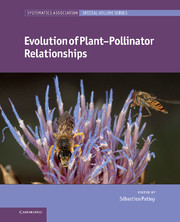Book contents
- Frontmatter
- Contents
- Contributors
- Preface
- 1 Macroevolution for plant reproductive biologists
- 2 Pollination crisis, plant sex systems, and predicting evolutionary trends in attractiveness
- 3 Evolution and ecological implications of “specialized” pollinator rewards
- 4 Fig–fig wasp mutualism: the fall of the strict cospeciation paradigm?
- 5 Fossil bees and their plant associates
- 6 Pollen evidence for the pollination biology of early flowering plants
- 7 Pollinator mediated floral divergence in the absence of pollinator shifts
- 8 Animal pollination and speciation in plants: general mechanisms and examples from the orchids
- 9 Why are floral signals complex? An outline of functional hypotheses
- 10 A survey on pollination modes in cacti and a potential key innovation
- 11 Zygomorphy, area, and the latitudinal biodiversity gradient in angiosperms
- 12 Ambophily and “super generalism” in Ceratonia siliqua (Fabaceae) pollination
- 13 Structure and dynamics of pollination networks: the past, present, and future
- 14 Pollinators as drivers of plant distribution and assemblage into communities
- 15 Effects of alien species on plant–pollinator interactions: how can native plants adapt to changing pollination regimes?
- 16 Pollen resources of non-Apis bees in southern Africa
- 17 Advances in the study of the evolution of plant–pollinator relationships
- Index
- Plate section
- References
16 - Pollen resources of non-Apis bees in southern Africa
Published online by Cambridge University Press: 05 January 2012
- Frontmatter
- Contents
- Contributors
- Preface
- 1 Macroevolution for plant reproductive biologists
- 2 Pollination crisis, plant sex systems, and predicting evolutionary trends in attractiveness
- 3 Evolution and ecological implications of “specialized” pollinator rewards
- 4 Fig–fig wasp mutualism: the fall of the strict cospeciation paradigm?
- 5 Fossil bees and their plant associates
- 6 Pollen evidence for the pollination biology of early flowering plants
- 7 Pollinator mediated floral divergence in the absence of pollinator shifts
- 8 Animal pollination and speciation in plants: general mechanisms and examples from the orchids
- 9 Why are floral signals complex? An outline of functional hypotheses
- 10 A survey on pollination modes in cacti and a potential key innovation
- 11 Zygomorphy, area, and the latitudinal biodiversity gradient in angiosperms
- 12 Ambophily and “super generalism” in Ceratonia siliqua (Fabaceae) pollination
- 13 Structure and dynamics of pollination networks: the past, present, and future
- 14 Pollinators as drivers of plant distribution and assemblage into communities
- 15 Effects of alien species on plant–pollinator interactions: how can native plants adapt to changing pollination regimes?
- 16 Pollen resources of non-Apis bees in southern Africa
- 17 Advances in the study of the evolution of plant–pollinator relationships
- Index
- Plate section
- References
Summary
Introduction
Southern Africa, which is the region south of the Rivers Cunene and Zambezi, is one of the world’s bee diversity hotspots (Kuhlmann 2009). As bees are the most important pollinators of flowering plants, including crops, they are ecological and economic keystone species (Corbet et al. 1991; Allen-Wardell et al. 1998; Klein et al. 2007). Pollinators are believed to have played an important role in plant speciation in southern Africa, especially in the Cape Floral Kingdom (Kreft and Jetz 2007; van der Niet and Johnson 2008; Waterman et al. 2008). Notwithstanding the great economic, ecological, and evolutionary significance of wild bees, knowledge of this important group of pollinators and their floral relationships in this region is poor.
Struck (1990, 1994a, 1994b, 1995) was the first to extensively study the relationships between flowers and solitary bees in southern Africa. In his pioneering work in Namaqualand, he used pollen analyses for recording flower visitation to investigate flower specialization of bees and other flower visiting insects. But due to taxonomic uncertainties in many of the bee genera in those days, the published data is of limited usefulness without the re-examination of the specimens, and thus it is not considered here.
- Type
- Chapter
- Information
- Evolution of Plant-Pollinator Relationships , pp. 439 - 457Publisher: Cambridge University PressPrint publication year: 2011
References
- 2
- Cited by



